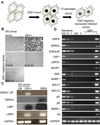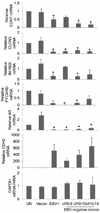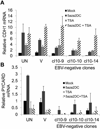Epstein-Barr virus-induced epigenetic alterations following transient infection
- PMID: 23047626
- PMCID: PMC3578144
- DOI: 10.1002/ijc.27893
Epstein-Barr virus-induced epigenetic alterations following transient infection
Abstract
Epstein-Barr virus (EBV) is a known tumor virus associated with an increasing array of malignancies; however, the association of the virus with certain malignancies is often erratic. To determine EBV's contributions to tumorigenesis in a setting of incomplete association, a transient model of infection was established where a clonal CCL185 carcinoma cell line infected with recombinant EBV was allowed to lose viral genomes by withdrawal of selection pressure. Global gene expression comparing EBV-negative, transiently infected clones to uninfected controls identified expression changes in more than 1,000 genes. Among downregulated genes, several genes known to be deoxyribonucleic acid (DNA) methylated in cancer were identified including E-cadherin and PYCARD. A cadherin switch, increased motility and enhanced cellular invasiveness present in EBV-positive cells were retained after viral loss, indicating an epigenetic effect. Repression of PYCARD expression was a result of increased promoter CpG methylation, whereas loss of E-cadherin expression after transient EBV infection did not correlate with increased DNA methylation of the E-cadherin promoter. Rather, repression of E-cadherin was consistent with the formation of a repressive chromatin state. Decreased histone 3 or 4 acetylation at the promoter and 5' end of the E-cadherin gene was observed in an EBV-negative, transiently infected clone relative to the uninfected controls. These results suggest that EBV can stably alter gene expression in a heritable fashion in formerly infected cells, whereas its own contribution to the oncogenic process is masked.
Copyright © 2012 UICC.
Figures






Similar articles
-
CpG-methylation regulates a class of Epstein-Barr virus promoters.PLoS Pathog. 2010 Sep 23;6(9):e1001114. doi: 10.1371/journal.ppat.1001114. PLoS Pathog. 2010. PMID: 20886097 Free PMC article.
-
BZLF1 governs CpG-methylated chromatin of Epstein-Barr Virus reversing epigenetic repression.PLoS Pathog. 2012 Sep;8(9):e1002902. doi: 10.1371/journal.ppat.1002902. Epub 2012 Sep 6. PLoS Pathog. 2012. PMID: 22969425 Free PMC article.
-
Genome-wide DNA methylation as an epigenetic consequence of Epstein-Barr virus infection of immortalized keratinocytes.J Virol. 2014 Oct;88(19):11442-58. doi: 10.1128/JVI.00972-14. Epub 2014 Jul 23. J Virol. 2014. PMID: 25056883 Free PMC article.
-
The Role of Epigenetic Regulation in Epstein-Barr Virus-Associated Gastric Cancer.Int J Mol Sci. 2017 Jul 25;18(8):1606. doi: 10.3390/ijms18081606. Int J Mol Sci. 2017. PMID: 28757548 Free PMC article. Review.
-
Epstein-Barr virus and gastric carcinoma.Pathol Int. 2010 May;60(5):337-50. doi: 10.1111/j.1440-1827.2010.02533.x. Pathol Int. 2010. PMID: 20518883 Review.
Cited by
-
EBV Association with Lymphomas and Carcinomas in the Oral Compartment.Viruses. 2022 Dec 1;14(12):2700. doi: 10.3390/v14122700. Viruses. 2022. PMID: 36560704 Free PMC article. Review.
-
Synergistic Viral Replication of Marek's Disease Virus and Avian Leukosis Virus Subgroup J is Responsible for the Enhanced Pathogenicity in the Superinfection of Chickens.Viruses. 2018 May 18;10(5):271. doi: 10.3390/v10050271. Viruses. 2018. PMID: 29783672 Free PMC article.
-
Multi-layered control of PD-L1 expression in Epstein-Barr virus-associated gastric cancer.J Cancer Metastasis Treat. 2020;6(13):10.20517/2394-4722.2020.12. doi: 10.20517/2394-4722.2020.12. Epub 2020 May 23. J Cancer Metastasis Treat. 2020. PMID: 34212113 Free PMC article.
-
Epstein-Barr virus infection and nasopharyngeal carcinoma.Philos Trans R Soc Lond B Biol Sci. 2017 Oct 19;372(1732):20160270. doi: 10.1098/rstb.2016.0270. Philos Trans R Soc Lond B Biol Sci. 2017. PMID: 28893937 Free PMC article. Review.
-
Extranodal NK/T-cell lymphoma, nasal type without evidence of EBV infection.Oncol Lett. 2020 Sep;20(3):2665-2676. doi: 10.3892/ol.2020.11842. Epub 2020 Jul 9. Oncol Lett. 2020. PMID: 32782583 Free PMC article.
References
-
- Epstein MA, Achong BG, Barr YM. Virus Particles in Cultured Lymphoblasts from Burkitt's Lymphoma. Lancet. 1964;1:702–703. - PubMed
-
- Herbst H, Stein H, Niedobitek G. Epstein-Barr virus and CD30+ malignant lymphomas. Crit Rev Oncog. 1993;4:191–239. - PubMed
-
- Levine PH, Ablashi DV, Berard CW, Carbone PP, Waggoner DE, Malan L. Elevated antibody titers to Epstein-Barr virus in Hodgkin's disease. Cancer. 1971;27:416–421. - PubMed
Publication types
MeSH terms
Substances
Grants and funding
LinkOut - more resources
Full Text Sources
Medical
Molecular Biology Databases
Miscellaneous

